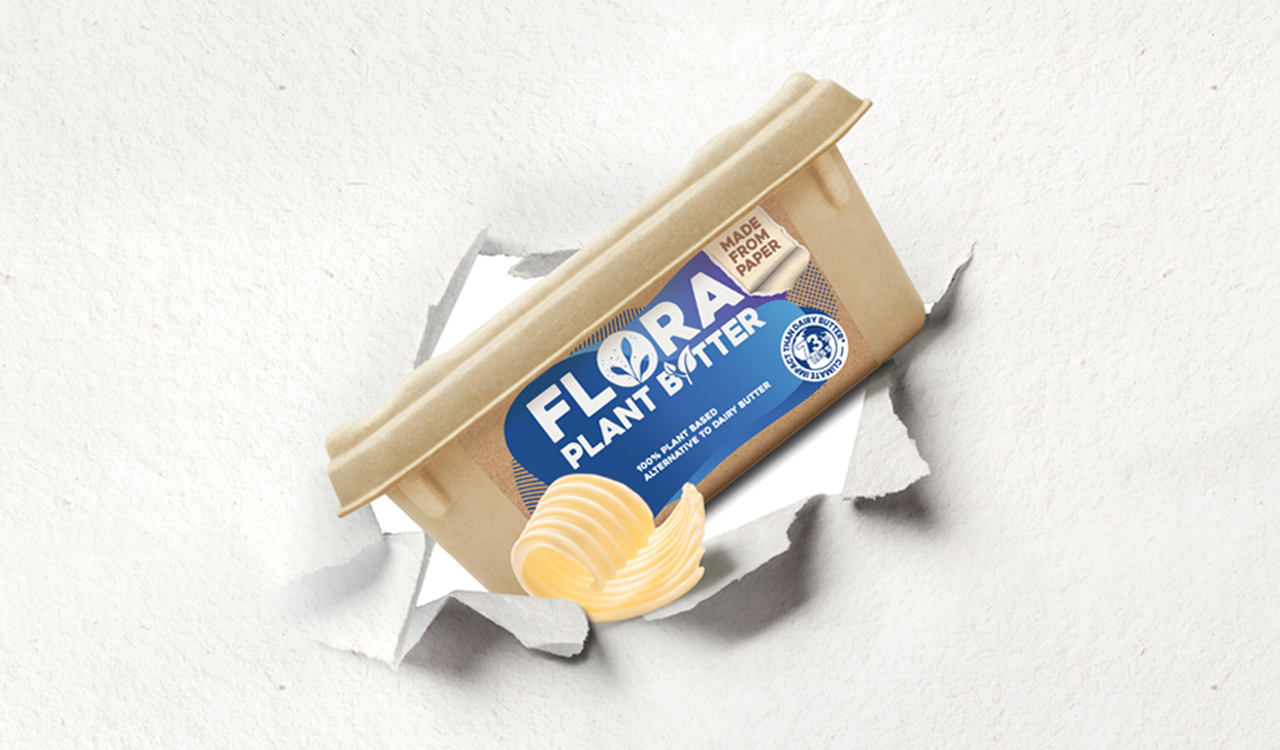Our natural ingredients come from plants, and we are working to make sure our packaging does too. The packaging we use for our products is how we protect them against damage, minimise food waste and maintain our high standards of food safety and quality. Until now, our industry has relied on plastic as the optimal material to achieve these ends, but we are leading the charge in finding a new way.
Whilst our plastic packaging is designed to be recycled, we know that not all of it is. That is why we have pioneered new paper tub packaging for spreads like Flora, made from compressed wet paper fibers, that is plastic-free, oil-resistant and is fully recyclable. This will allow us to transition away from over 750,000 plastic tubs annually for Flora in Europe alone. Along with other innovations like thinner plastic pots, this paper tub signifies important progress towards our goal of reducing plastic packaging by 80% (per tonne of production) by 2030.
Going plastic-free is a huge task – we will continue to harness the brainpower of our R&D department, form collaborations, and work with recycling organisations to achieve our ambitious goal of eliminating avoidable plastic.
Our main packaging formats are tubs, wrappers and sachets, and they are currently made from plastic or contain plastic in their structure. To replace plastic is challenging, as we must ensure that any new materials protect our product and are intelligently designed for our supply chain. Consumers must trust that our packaging will still be recyclable, compostable, or reusable and account for the climate impact of packaging also. We have set a stretching goal to eliminate 80% of our plastic packaging by 2030, and are innovating with partners to achieve this. With our tubs specifically, we have pioneered new paper tub packaging made from compressed wet paper fibers. This plastic-free, oil-resistant paper tub is fully recyclable. The launch of this tub has already allowed us to transition away from over 750,000 plastic tubs annually for Flora in Europe alone. This innovation represents important progress as we continue collaborating with partners like Footprint to reimagine our packaging in more sustainable ways and meet our ambitious plastic reduction goals.
-
What changes will consumers notice with the new paper packaging?
-
How does the new paper packaging impact recycling?
-
Where does the paper for the new packaging come from?
-
How long did it take to develop the new paper packaging?
-
What are the main benefits of the new paper packaging?
-
How does the new packaging align with Upfield's sustainability goals?
We are not just working to tackle plastic waste. We are also committed to reducing the carbon footprint associated with our packaging, as we develop new packaging formats. We will introduce better packaging solutions that reduce the climate impact of our packaging footprint and we will also increase the use of renewable materials. As always, we will track and measure this commitment by conducting Life Cycle Assessments (LCAs) on the impact of our packaging and communicate with consumers about lower-impact packaging materials to encourage sustainable consumption. We are also rolling out carbon labelling on our packaging to promote environmental transparency to our consumers. Check out our work on Carbon Labelling here.
We are working to make our packaging more circular by increasing recycled content and ensuring all our packaging is recyclable, reusable or compostable. Over 90% of our packaging is already recyclable, reusable or compostable and our goal is to ensure all our packaging in recyclable by 2030, as well as doubling our use of recycled content. Where our materials come from is also important - we ensure, for example, that all the paper and cardboard we use is sustainably sourced and both materials can be made with high levels of recycled content
Our other pillars
Plant based
GOAL: 1 billion people choose our delicious plant-based products.
Healthier lives
Goal: 200 million lives positively impacted with access to affordable and healthy nutrition.
Better planet
GOAL: Pioneer food that's better for the planet. Showcase our plant-based benefits while reducing our own footprint.


